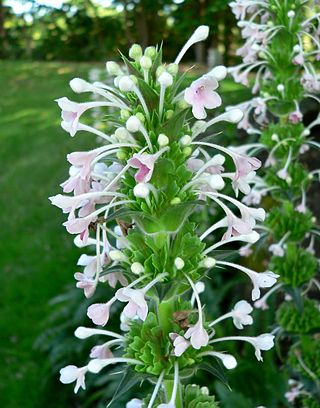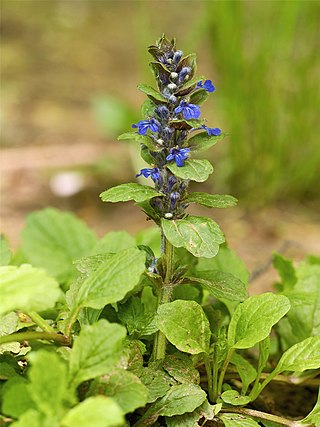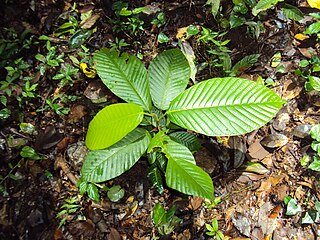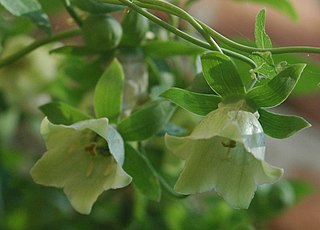
Morina is a genus flowering plants in the family Caprifoliaceae. It includes 14 species native to Eurasia, ranging from southeastern Europe through Western and Central Asia to the Himalayas, China, Bangladesh, and Myanmar. It is named in honor of Louis Morin de Saint-Victor (1635–1715), a French physician, botanist and meteorologist.

Ajuga, also known as bugleweed, ground pine, carpet bugle, or just bugle, is a genus of flowering plants in the Ajugeae tribe of the mint family Lamiaceae. There are over 60 species of annual or perennial, mostly herbaceous plants. They are native to Europe, Asia, Africa, and Australia.

Adenophora is a genus of flowering plants in the family Campanulaceae, the bellflowers. Plants of this genus are known commonly as ladybells. Most of the species in the genus are native to eastern Asia, with a few in Europe. Many are endemic to either China or Siberia.

Gaultheria is a genus of about 283 species of shrubs in the family Ericaceae. The name commemorates Jean François Gaultier of Quebec, an honour bestowed by the Scandinavian Pehr Kalm in 1748 and taken up by Carl Linnaeus in his Species Plantarum. These plants are native to Asia, Australasia and North and South America. In the past, the Southern Hemisphere species were often treated as the separate genus Pernettya, but no consistent reliable morphological or genetic differences support recognition of two genera, and they are now united in the single genus Gaultheria.

Osmanthus is a genus of about 30 species of flowering plants in the family Oleaceae. Most of the species are native to eastern Asia with a few species from the Caucasus, New Caledonia, and Sumatra. Osmanthus has been known in China since ancient times with the earliest writings coming from the Warring States period; the book Sea and Mountain. South Mountain states: "Zhaoyao Mountain had a lot of Osmanthus".

Dipterocarpus is a genus of flowering plants and the type genus of family Dipterocarpaceae.

Acer tataricum, the Tatar maple or Tatarian maple, is a species of maple widespread across central and southeastern Europe and temperate Asia, from Austria and Turkey, and in some circumscriptions, with a disjunct population in eastern Asia in northern and central China, Japan and the Russian Far East. The species is named after the Tatar peoples of southern Russia; the tree's name is similarly commonly also misspelled "Tartar" or "Tartarian" in English.

Phoebe is a genus of evergreen trees and shrubs belonging to the Laurel family, Lauraceae. There are 75 accepted species in the genus, distributed in tropical and subtropical Asia and New Guinea. 35 species occur in China, of which 27 are endemic. The first description of the genus was of the type species P. lanceolata made in 1836 by Christian Gottfried Daniel Nees von Esenbeck in Systema Laurinarum, p. 98.

Rohdea is a genus of plants native to eastern Asia. It was long thought to contain only a single species, R. japonica, but recent studies have resulted in several other taxa being transferred into the genus.

Codonopsis is a genus of flowering plant in the family Campanulaceae. As currently recognized, Codonopsis includes two other groups sometimes separated as distinct genera, i.e. Campanumoea and Leptocodon. The enlarged genus Codonopsis is widespread across eastern, southern, central, and southeastern Asia, including China, Japan, the Russian Far East, Kazakhstan, the Indian Subcontinent, Iran, Indochina, Indonesia, etc.

The Hengduan Mountains are a group of mountain ranges in southwest China that connect the southeast portions of the Tibetan Plateau with the Yunnan–Guizhou Plateau. The Hengduan Mountains are primarily large north-south mountain ranges that effectively separate lowlands in northern Myanmar from the lowlands of the Sichuan Basin. These ranges are characterized by significant vertical relief originating from the Indian subcontinent's collision with the Eurasian Plate, and further carved out by the major rivers draining the eastern Tibetan Plateau. These rivers, the Yangtze, Mekong, and Salween, are recognized today as the Three Parallel Rivers UNESCO World Heritage Site.

Aletris, the colicroot, colicweed, crow corn, or unicorn root, is a genus of flowering plants in the family Nartheciaceae, native to North America and to eastern and southeastern Asia, especially China. It was used as a component in Lydia Pinkham's original Vegetable Compound.

The Eastern Himalayan alpine shrub and meadows is a montane grasslands and shrublands ecoregion of Bhutan, China, India, Myanmar, and Nepal, which lies between the tree line and snow line in the eastern portion of the Himalaya Range.

Apios is a genus of flowering plants in the family Fabaceae. It belongs to the subfamily Faboideae. It contains seven species of perennial climbing herbs or scandent shrubs. Several members of this genus are known to have edible, tuberous roots.

Pteris cretica, the Cretan brake, ribbon fern, or Cretan brake fern, is a species of evergreen fern in the family Pteridaceae, native to Europe, Asia and Africa.
Microtoena is a genus of flowering plants in the mint family, Lamiaceae, first described in 1889. It is native to eastern and southeastern Asia, primarily China.
- Microtoena albescensC.Y.Wu & S.J.Hsuan - Guizhou
- Microtoena bhutanicaStearn - Bhutan
- Microtoena coreanaH.Lév - Korea
- Microtoena delavayiPrain - Sichuan, Yunnan
- Microtoena esquiroliiH.Lév. - Yunnan, Guizhou, Guangxi
- Microtoena griffithiiPrain - Arunachal Pradesh, Bangladesh
- Microtoena insuavis(Hance) Prain ex Briq. - Thailand, Vietnam, Guangdong, Guizhou, Yunnan
- Microtoena longisepalaC.Y.Wu - Sichuan
- Microtoena maireanaHand.-Mazz. - Yunnan
- Microtoena megacalyxC.Y.Wu - Guizhou, Yunnan
- Microtoena miyiensisC.Y.Wu & H.W.Li - Sichuan
- Microtoena mollisH.Lév. - Guizhou, Yunnan, Guangxi
- Microtoena moupinensis(Franch.) Prain - Tibet, Sichuan
- Microtoena muliensisC.Y.Wu - Sichuan
- Microtoena nepalensisStearn - Nepal
- Microtoena omeiensisC.Y.Wu & S.J.Hsuan - Sichuan
- Microtoena patchoulii(C.B.Clarke ex Hook.f.) C.Y.Wu & S.J.Hsuan - from Yunnan + Nepal south to Java
- Microtoena paucifloraC.Y.Wu - Yunnan
- Microtoena praineanaDiels - Guizhou, Sichuan, Yunnan
- Microtoena robustaHemsl. - Sichuan, Hubei
- Microtoena stenocalyxC.Y.Wu & S.J.Hsuan - Yunnan
- Microtoena urticifoliaHemsl. - Hubei, Hunan
- Microtoena vanchingshanensisC.Y.Wu & S.J.Hsuan - Guizhou
- Microtoena wardiiStearn - Tibet, Bhutan, Arunachal Pradesh

Alseodaphnopsis is a genus of flowering plants belonging to the family Lauraceae.

Omphalogramma is a genus of flowering plants belonging to the family Primulaceae.

















